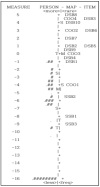The Psychometric Properties of the Trunk Impairment Scale in Children with Cerebral Palsy
- PMID: 35327807
- PMCID: PMC8946874
- DOI: 10.3390/children9030435
The Psychometric Properties of the Trunk Impairment Scale in Children with Cerebral Palsy
Abstract
The Trunk Impairment Scale (TIS) measures static and dynamic seated trunk control in children with cerebral palsy (CP) who have postural control problems. Studies have investigated the reliability and validity of the TIS. However, the fitness and difficulty of the scale items have not been investigated. This study used Rasch analysis to test the construct validity of TIS for children with CP. TIS data were collected from 60 children with CP and analyzed for person and item fit, item difficulty, rating scale suitability, and separation reliability. Principal component analyses of residuals revealed that TIS had unidimensionality. Five misfit items (static sitting balance (SSB) items 2 and 3, dynamic sitting balance (DSB) items 4 and 5, and coordination (COO) item 3) were identified. DSB8 is the most difficult item, followed by DSB3 and COO4. On the other hand, the SSB3 item was found to be a relatively easy item. The rating scales demonstrated that out of the three subscales, SSB, DSB, and COO, only the SSB subscale did not meet the appropriate criteria. We demonstrated that statistical item analysis with the Rasch model could provide valuable information related to psychometric properties.
Keywords: Rasch analysis; cerebral palsy; children; psychometric; trunk impairment scale.
Conflict of interest statement
The authors declare that they have no conflict of interest.
Figures


Similar articles
-
Investigating the internal validity of the Trunk Impairment Scale (TIS) using Rasch analysis: the TIS 2.0.Disabil Rehabil. 2010;32(25):2127-37. doi: 10.3109/09638288.2010.483038. Epub 2010 Jun 22. Disabil Rehabil. 2010. PMID: 20569077
-
Discriminant ability and criterion validity of the Trunk Impairment Scale for cerebral palsy.Disabil Rehabil. 2019 Sep;41(18):2199-2205. doi: 10.1080/09638288.2018.1462410. Epub 2018 Apr 17. Disabil Rehabil. 2019. PMID: 29663838
-
Psychometric properties of the caregiving difficulty scale in mothers of children with cerebral palsy.BMC Neurol. 2023 Jun 20;23(1):237. doi: 10.1186/s12883-023-03264-w. BMC Neurol. 2023. PMID: 37340392 Free PMC article.
-
Enhancing the usefulness of the Mini-BESTest for measuring dynamic balance: a Rasch validation study.Eur J Phys Rehabil Med. 2015 Aug;51(4):429-37. Epub 2015 Feb 5. Eur J Phys Rehabil Med. 2015. PMID: 25653078
-
The psychometric properties of the Childhood Health Assessment Questionnaire (CHAQ) in children with cerebral palsy.BMC Neurol. 2018 Sep 20;18(1):151. doi: 10.1186/s12883-018-1154-9. BMC Neurol. 2018. PMID: 30236077 Free PMC article.
References
-
- Paneth P.N., Leviton A., Goldstein M., Bax M., Damiano D., Dan B., Jacobsson B. A report: The definition and classification of cerebral palsy April 2006. Dev. Med. Child Neurol. 2007;109:8–14. - PubMed
-
- Redstone F., West J.F. The importance of postural control for feeding. Pediatr. Nurs. 2004;30:97–100. - PubMed
-
- Love S.R., Johnston L.M. Exercise interventions improve postural control in children with cerebral palsy: A systematic review. Dev. Med. Child Neurol. 2015;57:504–520. - PubMed
LinkOut - more resources
Full Text Sources
Miscellaneous

